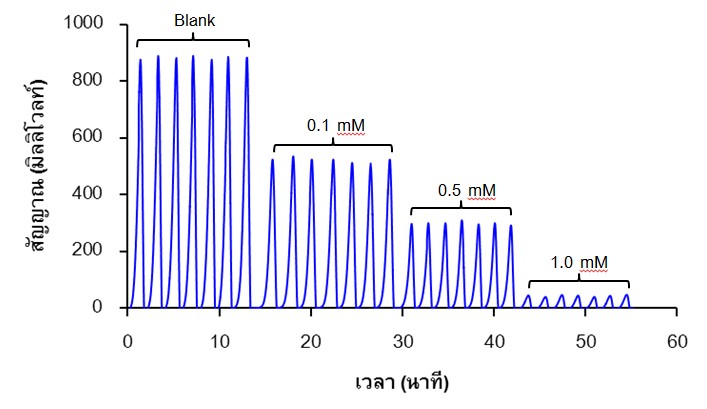ระบบโฟลอินเจคชันสเปกโทรโฟโตเมตรีสำหรับการประเมินฤทธิ์ต้านอนุมูลอิสระ
Main Article Content
Abstract
Khuanjit Hemavibool and Sairoong Ouypornkochagorn
รับบทความ: 7 มกราคม 2560; ยอมรับตีพิมพ์: 30 เมษายน 2560
บทคัดย่อ
ระบบโฟลอินเจคชันสเปกโทรโฟโตเมตรีแบบง่ายพัฒนาขึ้นสำหรับการประเมินฤทธิ์ต้านอนุมูลอิสระ โดยวิเคราะห์ด้วยหลักการตรวจวัดความเข้มข้นของสารละลาย DPPH ที่ลดลงเนื่องจากการทำปฏิกิริยากับสารต้านอนุมูลอิสระด้วยเทคนิคทางสเปกโทรโฟโตเมตรี และศึกษาสภาวะที่เหมาะสมของระบบโฟลอินเจคชัน ได้แก่ ปริมาณของสารละลาย DPPH ปริมาณของสารต้านอนุมูลอิสระ อัตราการไหล และความยาวของขดท่อผสม ในการทดลองนี้ใช้กรดแอสคอร์บิกเป็นสารละลายมาตรฐานในการทดสอบการวิเคราะห์ด้วยระบบโฟลอินเจคชันและใช้เป็นสารเทียบมาตรฐานในการวิเคราะห์ฤทธิ์ของสารต้านอนุมูลอิสระ โดยจากผลการวิเคราะห์ฤทธิ์การต้านอนุมูลอิสระของโทรลอกซ์ พบว่า ให้ผลสอดคล้องกับวิธีมาตรฐานเมื่อเปรียบเทียบด้วย paired t–test ที่ช่วงความเชื่อมั่น 95%
คำสำคัญ: ฤทธิ์ต้านอนุมูลอิสระ วิธีดีพีพีเอช ระบบโฟลอินเจคชัน สเปกโทรโฟโตเมตรี
Abstract
A simple flow injection spectrophotometric system was developed for the evaluation of antioxidant capacity. The analysis was based on the spectrophotometric measurement of the DPPH concentration decrease resulting from the reaction with an antioxidant compound. The optimization of flow injection system was investigated including amount of DPPH and antioxidant solution, flow rate and reaction coil length. Ascorbic acid was used as a standard compound to validate the flow injection system and served as a reference antioxidant to measure the relative antioxidation. From the analysis of antioxidant capacity of trolox, the results gave good agreement to the standard DPPH method by comparing with paired t–test at 95% confidence interval.
Keywords: Antioxidant capacity, DPPH assay, Flow injection system, Spectrophotometry
Downloads
Article Details

This work is licensed under a Creative Commons Attribution-NonCommercial 4.0 International License.
References
Babu, D., Gurumurthy, P., Borra, S. K., and Cherian, K. M. (2013). Antioxidant and free radical scavenging activity of triphala determined by using different in vitro models. Journal of Medicinal Plants Research 7(39): 2898–2905.
Berker, K. I., Guclu, K., Tor, I., and Apak, R. (2007). Comparative evaluation of Fe (III) reducing power-based antioxidant capacity assays in the presence of phenanthroline, bathophenanthroline, tripyridyltriazine (FRAP) and ferricyanide reagents. Talanta 72: 1157–1165.
Hudson, B. J. (1990). Food Antioxidants. Essex: Springer Science & Business Media.
Jirum, J., and Srihanam, P. (2011). Oxidants and antioxidants: Sources and mecha-nism. Academic Journal of Kalasin Rajabhat University 1(1): 59–70. (in Thai)
Kedare, S. B., and Singh, R. P. (2011). Genesis and development of DPPH method of antioxidant assay. Journal of Food Science and Technology 48(4): 412–422.
Lu, Y., Khoo, T. J., and Wiart C. (2014) Anti-oxidant activity determination of citronellal and crude extracts of Cymbopogon citratus by 3 different methods. Pharmacology and Pharmacy 5: 395–400.
Nookrai, M., Watla-iad, K., Deachathai, S., and Suteerapataranon, S. (2012) Rapid antioxidant capacity screening in herbal extracts using a simple flow injection-spectrophotometric system. Food Chemistry 132: 544–548.
Phansawan, B. (2013). Free radicals, antioxidants and antioxidant activity determination. Journal of Science & Technology, Thammasat University 21(3): 275–286. (in Thai)
Satish, B. N., and Dilipkumar, P. (2015). Free radicals, natural antioxidants, and their reaction mechanisms. RSC Advances 5: 27086–28006.
Sharma, O. P., and Bhat, T. K. (2009). DPPH antioxidant assay revisited. Food Chemistry 113: 1202–1205.
Thaiponga, K., Boonprakoba, U., Crosbyb, K., Cisneros-Zevallosc, L., and Byrne, D. H. (2006). Comparison of ABTS, DPPH, FRAP, and ORAC assays for estimating antioxidant activity from guava fruit extracts. Journal of Food Composition and Analysis 19: 669–675.
